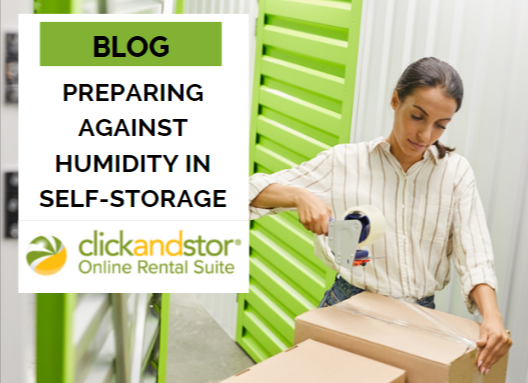

March 11, 2024
Preparing Against Humidity in Self-Storage
 We have identified one of the biggest culprits behind the possibility of damage to self-storage, and that is moisture. Humidity in the air is a natural process in the cycle of weather and climate in the elements, but it does not belong in a storage unit. Moisture is the enemy of sensitive items protected in a storage unit, and today we will help you with tips to combat it. If we work together, we can eliminate all potential risks to ensure secure storage of any items–within reason–that you wish to store.
We have identified one of the biggest culprits behind the possibility of damage to self-storage, and that is moisture. Humidity in the air is a natural process in the cycle of weather and climate in the elements, but it does not belong in a storage unit. Moisture is the enemy of sensitive items protected in a storage unit, and today we will help you with tips to combat it. If we work together, we can eliminate all potential risks to ensure secure storage of any items–within reason–that you wish to store.Consider Climate-Controlled Storage
Consider renting a climate-controlled storage unit. These units are equipped with temperature and humidity control, providing a stable environment for your belongings. Climate-controlled storage is not the same as air-conditioned, heated storage, and climate-controlled storage units are equipped with the capability to regulate the moisture in the environment rather than just the temperature. Remember to research and comply with the storage facility’s rules and regulations, as some facilities may have specific guidelines for humidity control and storage conditions.
Keep Items Dry
The best way to prevent moisture is to make sure it never shows up in the first place. By packing your possessions already dried and ready, you are further reducing the chances of moisture leaking in. Start by disassembling furniture. Take the legs off couches, remove drawers, and disassemble what you can to reduce any seepage of moisture.
Wrap individual items with care in breathable materials like cotton or linen to allow air circulation and avoid pieces rubbing together. Avoid using plastic for individual wrapping, as it can trap moisture and lead to mold growth. Keep boxes and furniture off the floor by using pallets or boards. This helps to minimize direct contact with any potential moisture on the ground and also provides another way to circulate airflow underneath the items you wish to store.
Maximize ventilation within your storage unit by leaving spaces between boxes, furniture, shelves, and other items. Avoid packing items too tightly, as this will cut off airflow. You also want to avoid packing belongings too tightly to prevent damage such as warping, scratching, or squashing.
Use Dehumidifying Tools
Moisture-wick packs are simple but vital tools to wick moisture out of the air. Desiccants (silica gel packets or moisture-absorbing products) should be placed inside boxes to absorb excess moisture. This helps prevent mold, mildew, and musty odors. Wrapped charcoal briquettes are also effective techniques to ensure dryness in the environment.
Other Tips
If using plastic containers, choose ones with airtight seals to keep out moisture. Be sure that the containers are clean and dry before packing. Seal boxes with high-quality packing tape to prevent moisture from getting inside. Double-tape the seams for added protection.
Clearly label boxes and organize items logically. We suggest making a list of items that you keep inside your unit and sketching out where these items are located within the unit. A little preparation goes a long way, and this makes it easier to access what you need without having to disturb the entire storage unit. Periodically check on your storage unit to ensure there are no signs of moisture or humidity issues. Consider using a dehumidifier if allowed in the storage facility.
Find climate-controlled storage easily and quickly with ClickandStor® Online Rental Platform.
Browse through a wide selection of storage solutions, visualizing your space easily with the storage calculator. Find the best deals on storage near you, easily book the rental you need online, and move in when you are ready. Prepare against the humidity today by visiting our website to begin.
